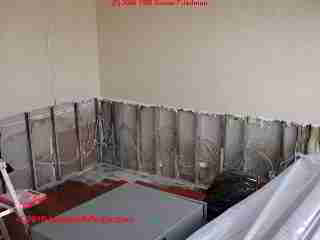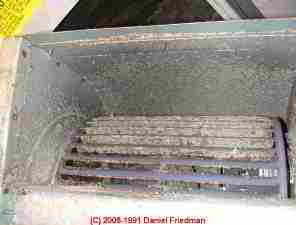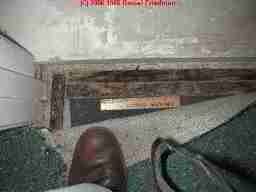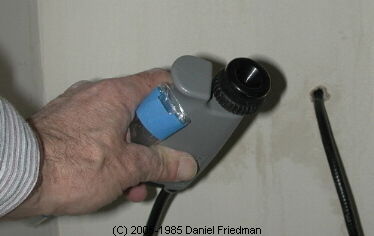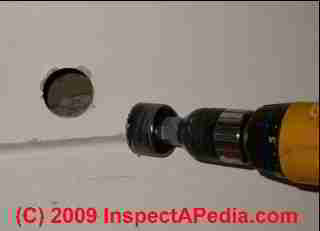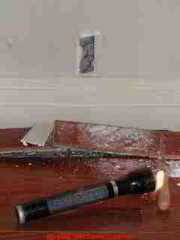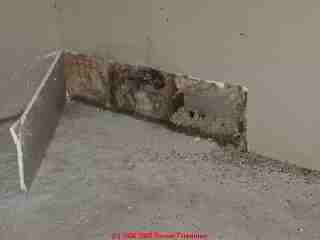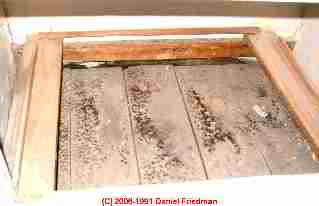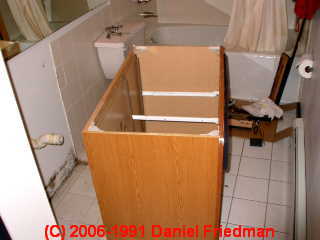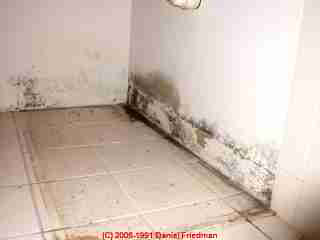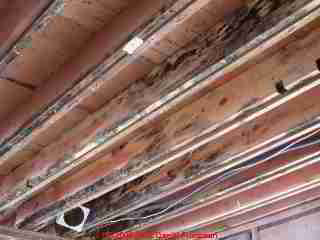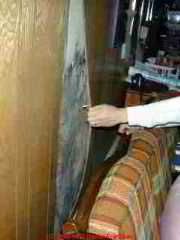 Find Hidden Mold Contamination
Find Hidden Mold Contamination
- POST a QUESTION or COMMENT about how to find hidden mold contamination in buildings
Find & fix hidden mold contamination:
This article series provides a Photo Guide to Finding Hidden Mold in Buildings - how to inspect a building for important but hidden toxic, allergenic, or otherwise harmful mold contamination.
This article begins our series of instructions on how to track down the source of hidden mold contamination in buildings. We include hidden mold investigation techniques and we provide procedural suggestions to avoid creating an unsafe condition or moldy mess during the mold investigation process.
The fact that mold is "hidden" in buildings does not mean one cannot find it. We look by context: where do we see leak stains, or where do we see building practices most likely to have produced a hidden leak or moisture problem? Ice dam leaks in walls, hidden plumbing leaks, roof spillage by the foundation, are all common clues that often track to a wet building wall or ceiling cavity and from there to a hidden mold problem which may need to be addressed.
InspectAPedia tolerates no conflicts of interest. We have no relationship with advertisers, products, or services discussed at this website.
in Buildings, Insulation Mold, and Other Hidden Mold Reservoirs in Buildings
This document describes how to find mold and test for mold in buildings, including how and where to collect mold samples using adhesive tape - an easy, inexpensive, low-tech but very effective mold testing method.
We discuss the problem of hidden mold reservoirs (photo at left) and steps to take to find such problems in buildings. The mold contamination show at left is described in more detail
at HIDDEN MOLD in CEILINGS / WALLS.
This procedure helps identify the presence of or locate the probable sources of mold reservoirs in buildings, and helps decide which of these need more invasive, exhaustive inspection and testing.
In the photo at page top we see the results of a wall cut through drywall to expose wet moldy insulation, mold on the cavity side of drywall, and surprise! a leak in a pipe that the owner did not know was in her basement wall.
However there was good evidence in the form of stains on the exposed side of this drywall. Look at the tan stain which is in the photo in the half-round shape directly above the wall cutout.
Watch out: just a light touch is needed.
Don't try to investigate a building by dashing about with an axe cutting holes willy-nilly.
That is an unnecessarily and inappropriately destructive approach to studying a property. But when building history, occupant complaints, or direct site observation of site and building conditions raise the level of probability of an important hidden leak or other damage, directed exploration, often with very modest means, can be very productive.
An Example of "Hidden Mold" in Air Conditioner Air Handling Equipment
The photograph of a dense colonization of light-colored mold inside of a Florida air conditioning air handler unit above, courtesy of Mark Cramer, Tampa.
While it is certainly possible for HVAC equipment and duct work to form a problem reservoir of mold contamination in a building, we caution that small mold reservoirs in HVAC air handlers are common,
Often, because of the small size and mold genera found in an air handler, such reservoirs are not the problem mold reservoir in a building, and investigators need to look further.
Watch out: Do Not Open and Spread a Large Mold Reservoir While Looking for Hidden Mold
Making a small 4-inch test cut, using a borescope or a hole saw to look into building cavities, behind trim, or behind wallpaper, even pulling up a few inches of carpeting won't release a tremendous amount of toxic or allergenic mold into a building, and such openings can also be re-sealed or taped pending further investigation or cleaning.
But wholesale demolition, knocking down walls, removing wall to wall carpets, removing building insulation, or peeling back larger areas of wallpaper could indeed be unsafe if it exposes a large mold reservoir. Here is a warning from the US EPA on peeling back wallpaper or other hidden mold exploration methods:
Investigating hidden mold problems
Investigating hidden mold problems may be difficult and will require caution when the investigation involves disturbing potential sites of mold growth.
For example, removal of wallpaper can lead to a massive release of spores if there is mold growing on the underside of the paper. If you believe that you may have a hidden mold problem, consider hiring an experienced professional.
Where to look for hidden mold on and under carpeting and flooring
Lift carpets to inspect carpet tack strips and carpet padding and carpet underside.
Water stains on carpet tack strips and rusty carpet tacks on those strips are other indicators of the leak history in the area.
See this MOLDY CARPETS article.
Remember that mold may be present on the under-side of the carpet itself or on the top or under-side of carpet padding located below the actual carpeting. Hidden mold may be found on the floor surface below the carpeting, or even between layers of finish flooring and subflooring.
We also find mold quite often on the under-side of subflooring. Look up at subfloors from basements or crawl spaces; where a wooden subfloor is installed on furring or "sleepers" placed over a concrete slab, it may be necessary to cut small test openings to explore these hidden cavities.
The best place for a test cut to look for mold over an inaccessible floor or any other building cavity would be where we suspect that water has been most likely to be present, but openings may also be made in unobtrusive spots nearby, such as in a closet or under shelving where the cosmetic damage will be minimized.
See TRAPPED MOLD BETWEEN WOOD SURFACES for a discussion of the question of need to remove mold from mated building surfaces.
Use of Borescopes to Look for Mold in Building Cavities
Use borescopes or small test openings: in areas where we suspect leaks into building wall or ceiling cavities we may use a bore scope to peer into the cavity through an opening about the diameter of a pencil.
You may not have access to this equipment but there are other useful steps that can be taken to look for hidden mold.
Where there is a greater probability of leaks into a wall or ceiling, or where there are stains, we may use a larger hole saw, such as shown below This article describes the inspection of building wall, ceiling, or floor cavities.
Use of a round hole saw to make test openings in building ceilings, walls or floors to look for hidden mold or to collect core samples for analysis of layers of material
The photo above shows us cutting a round hole in a wall to expose the wall cavity. Please
see TEST CUTS for MOLD in BUILDING CAVITIES for details of this topic
Small homeowner test cuts in walls: Make small test cuts in drywall in areas most-likely to have been wet. Don't make a big dusty (or moldy-dusty) mess. Keep it small and clean. You may want to re-seal test openings after using them, pending cleanup or further action. Details of this procedure are
at HIDDEN MOLD in CEILINGS / WALLS.
Larger Wall Test Cuts to Check for Hidden Mold
Larger wall cut openings: We may make a larger cut if external evidence such as staining or rot are strong suggestions of a wet, damaged, or moldy wall cavity.
See TEST CUTS for MOLD in BUILDING CAVITIES for details.
Photo Guide to Finding Hidden Mold on Furniture, Bathroom Vanities, & Built-In Drawers or Shelving
Look for hidden mold under drawers in areas subject to spills, leaks, or dampness, such as in bathrooms and kitchens. Inspect the drawer underside and the wood flooring exposed if built-in drawers are removed completely.
Moldy furniture guide: We also inspect the under-side of furniture, especially in areas that have been wet or humid. These "hidden" un-painted or un-varnished wood surfaces often support mold growth before it will be visible on the sealed or painted (and more moisture-resistant) surfaces.
Game tables such as pool tables usually include un-finished surfaces on their undersides. Chipboard, and even vinyl-covered chipboard are often very friendly to un-wanted Aspergillus sp. or Penicillium sp. mold growth.
Photo Guide to Finding Mold Under or Behind Bathroom Vanity Cabinets
If there has been protracted leakage or spillage under built-in cabinets such as bath vanities, there may be a mold cleanup job under or behind these components. We removed this bath vanity after receiving complaints of recurrent moldy odor in this bathroom. No amount of cleaning of other bath surfaces had reduced the mold smell.
A slight slope in the bathroom floor had been sending tub spillage behind this bath vanity for decades.
What makes a lot of sense sense is to study the building carefully to decide on the building points at most risk of having been wet from leaks due to construction details or other site observations. That's where one would make a test cut.
We frequently add text and photos to this series of articles. (See "What MOld Looks Like" and "Stuff that is Not Mold"a rticles. Readers should also
review MOLD in FIBERGLASS INSULATION in Buildings at
our MOLD INFORMATION CENTER - What to Do About Mold in Buildings
Small amounts of mold can be removed simply by cleaning or removing infected materials, something most homeowners can handle -- but see the Warning Notice at the end of this article. Some mold species can make you sick.
How to Identify Hidden & Visible Molds that are Cosmetic or Harmless, or Other Low-Risk Molds
Cosmetic-only Ceratocystis/Ophistoma bluestain mold is shown on the floor joists in the new construction framing in the photo just above.
This is a harmless, cosmetic-only mold that does not damage the lumber and is not a pathogen for humans. Here's a good example of the observation that not all "black mold" is "toxic black mold". It will be totally hidden when the ceiling drywall is installed.
The mold shown in the photograph above is plain to see during construction, but will be covered and hidden completely when the contractor installs the ceiling drywall.
One of our clients discovered this mold during a renovation and was quite concerned that a major toxic black mold reservoir had been found in the building. The client was facing a very costly mold cleanup project if this mold had to be addressed as a toxic material. Luckily this was not the case in this instance, as was easily demonstrated both by a simple inexpensive lab test and confirmed by onsite inspection of other framing details discussed at "Cosmetic Molds" linked-below.
So sometimes the mold in your house might be only a cosmetic concern. "Bluestain" or Ceratocystis/Ophistoma is common on framing lumber and we often find it in attics on the under side of roof sheathing. Unless it's in finished portions of living space where it creates a cosmetic problem, no particular action needed to address this black mold.
Detailed advice about how to determine by visual inspection alone whether or not you're probably looking at one of these common framing lumber cosmetic molds is at our Photo Guide
Reader Question: I have a hidden mold problem but none of my "mold inspectors" has been able to find it. How should I proceed?
I am convinced I have a "hidden mold" problem in one of my bathrooms, and have had this problem for quite some time. At times I have smelled a moldy odor, and almost always when I enter the room I IMMEDIATELY experience allergy symptoms.
I have made a visual inspection of the surfaces in the room, and see no mold deposits. I also had a chance to look at the under flooring (the plywood base layer for the floor) a couple of years ago, including the area right adjacent to the toilet bowl, when I had the old tile removed and new tile installed. There didn't appear to be any significant mold signs there.
I also had a handyman cut out two 24" square panels of drywall directly underneath the pipes of both sinks in this room, and although we couldn't see much further than the immediate areas, there were no signs of mold on the inside of the drywall or surrounding areas.
I am affected seriously in terms of health by this problem, and am very concerned about finally finding some way to pinpoint this problem, so I can have it resolved. (I can't afford to completely rip apart the room....walls, floors, ceilings...to find this problem, and further, my residence is a condo, with neighbors underneath and on one side on the same floor, so drastic measures would be difficult to take).
I have had two or three so-called "mold inspectors" out over the last few years, and none was effective. They tried to sell me "mold testing," but to me, this will do no good because
I already KNOW I have mold...the problem is, to FIND it, so I can have it removed. Any suggestions, and any local referrals you can make for services in my area (Arlington Heights, IL, a suburb northwest of Chicago), will be much appreciated. - M.R.
Reply: Be sure that the mold inspection is sufficiently broad in scope, identify risk targets for further investigation, don't rely on "mold tests" alone, and hire an expert who actually inspects
A competent onsite inspection by an expert usually finds additional clues that help accurately diagnose a problem. It is possible that the inspectors who looked in the past lacked experience or care, or that their inspection scope was too limited. Certainly if you smell mold it would be a surprise for none to be present.
And I agree that a "mold test" without an expert inspection is of little value and that it would fail to provide what's needed: a problem diagnosis and a start to an action plan.
Profile the Building's Leak or Moisture History to Track Down Hidden Mold
If you haven't seen it take a look
at HIDDEN MOLD, HOW TO FIND and the articles listed immediately under that heading .
One of those articles, USE a FLASHLIGHT to FIND MOLD adds another dimension, careful use of light to see hard-to-spot light colored molds.
In the case you describe, where you are already sure that there is a mold problem somewhere but it remains hidden, and where someone has already looked in the obvious places, including modest invasive inspecting by cutting openings at nearby plumbing, my suggestion is to perform a thorough, complete building inspection identifying by observation of construction details, building and site visual clues, building age, history, construction materials and similar approaches, all of the places that present a notable risk of a history of leaks or moisture traps.
Moisture Clues Help Track Down Hidden Mold
Moisture is a gating factor in problem mold growth. That inspection should result in selecting the top few highest-risk locations for further investigation, invasive cutting of limited openings included, if needed.
Smell Testing can Help Track Down Hidden Mold
I'd combine that approach with a careful sniff test or smell test to see if you can track mold smell to mold risk points.
See SMELL PATCH TEST to FIND ODOR SOURCE
More about pinpointing odor or smell sources in buildings begins
at
ODORS, Smells, Gases in Buildings-Diagnosis & Cure
We can't know from the data at hand so far whether or not the m
old problem in your building is small or if professional cleaning will be needed. That will be part of the discovery process.
Strategic Dust Sampling to Track Down Hidden Mold
As a part of a thorough mold investigation, I'd collect settled dust samples from suspect areas and from a few interesting areas on each building floor as a screening procedure. We might find evidence of nearby active mold growth (such as Pen/Asp spores found in chains) as well finding that some building areas are more moldy than others.
Movement of Mold Spores & Gases in Buildings Confound Hidden Mold Investigations
Keep in mind that because ultra-small mold spores as well as odors move through buildings like a gas, you may be smelling or detecting mold in areas that are not always immediately adjacent to the actual problem source.
Hire a Mold Investigator who Actually Investigates
About hiring a mold investigator, we list a variety of building inspection professionals beginning at the EXPERTS DIRECTORY (at page top). And near the top of that article you'll find lists of directories of other specialists including mold and environmental inspectors. Before hiring another inspector discuss your case and your concerns with the inspector and ask him/her to describe their procedure.
If you find that the "mold expert" is simply someone who is going to collect a few test samples and send them to a mold test lab, I'd look further for someone who will be more thorough and who has more experience and expertise. A more useful mold investigation includes taking a careful client complaint history, building age and materials and leak/moisture history, a very thorough outside and inside inspection for risk points, and strategic testing.
Variability in Human Response to Hidden Mold Reservoirs may Confound Mold Investigators
At MOLD EXPOSURE STANDARDS we provide a survey of mold exposure standards from around the world. You'll see that all of them set pretty high airborne mold spore levels and that not one of them copes with the enormous variability in individual mold genera/species spore size, allergenicity, pathogenicity, or toxicity.
Finally, by virtue of having my own forensic lab I've been able to perform some interesting tests on individual sensitivity to mold and MVOCs in buildings.
By testing individual clients and buildings in which the clients experienced a severe reaction immediately on entry (such as respiratory distress or allergic response) I found that some people are sensitive to very low levels of airborne mold spores of some genera. For example a woman client reacted within seconds of entry into a building where the airborne mold spore count was dominated by Aspergillus sp. at a level of less than 200 spores/M3 of air, a rather low indoor concentration.
Question: interpreting mold levels when I don't see the mold indoors
(June 1, 2014) John said:
I am buying a Condo and Elevated mold levels (14000 Aspergillus Pennicilum vs outdoors 600) have been detected by inspectors in two air tests. 2 Inspectors found No signs of visual mold, or any water in walls (thermal imaging), nothing under sinks, etc. There was a leak in to the bath ceiling 5 years ago and it was "caught and repaired immediately". AC is new -- only 1 year old but has some mold growing in 3 places. Seller wants to clean the AC system and ducts, do 2 days of air scrubbing and then do an immediate air test to see if the problem is fixed.
I am having the Bath ceiling inspected by having holes drilled and scoped and if needed cutting 6"x6" area.
Question -- without major construction -- just AC and duct remediation and air scrubbing, do we need 24 hours after the air scrubbing -- or can the air test be done immediately? Will and immediate test pick up another source of mold (not AC) if it exists -- or do we need to ewait 24 hours after air scrub?
Reply:
John,
Not much of this sounds sensible to me.
If a severe mold problem was found and repaired five years ago you would not be detecting high levels of indoor Penicillium sp. spores today.
I suspect the problem was never found, OR there have been other leaks and there are other mold reservoirs that need to be found and removed. This case illustrates why mold "tests" alone, without a competent inspection are not so helpful. We just have to visit the investigation de novo, this time, finding where the problem resides.
Please see (and continue the discussion at )
inspectapedia.com/mold/Find-Hidden-Mold.php
on how to find hidden mold
or at
inspectapedia.com/mold/Hidden-Mold-in-Ceiling-Wall.php
on making test cuts for mold. Scoping may not be adequate.
Question: moldy odors in attic after a new roof - what do we do?
(May 19, 2015) Charlene said:
We live in Colorado, and had new asphalt shingles installed in October 2011. Six months later, when warm weather arrived, I smelled a strong musty smell in the finished attic bedroom. By July, the smell went away. The next May, it was back, and again dissipated by summer.
This winter, we were in our garage, which has a vaulted roof and adjoins that bedroom, and we saw what we thought was snow creeping out between the roof and the garage wall. When examined closely, it turned out to be white mold, which is also growing in patches on the framing timbers inside the garage.
Our roofing contractor plans to remove several rows of shingles (and possibly decking) to try to find the problem. We have had a rainy spring and the smell is getting stronger while he waits for dry weather. We're not sure if we should notify our insurance company, or hire a mold inspector, or ? There is no visible sign of mold on the drywall in that room but luckily the smell is confined to that room, which is little used, so we just keep the door closed. Any suggestions would be welcome!
Reply:
Charlene
I think your roofer is on the right track: find the leak, follow the water, and we'll know where cleaning is needed. Besides there'd be not much success if we removed a mold problem but didn't fix the cause.
Take a look to be sure that insulation is not getting or didn't get soaked as if so that too may need replacement.
(May 19, 2015) Charlene said:
Thanks, that's good to know. I guess I'm nervous about the roofer's ability to find the leak, and fix it, and clean up properly to insure that we have no further issues. The moldy rafters in the garage span an area about 12 feet wide, so this is not an isolated problem. Do you think I should contact a mold-removal company and have them ready to go if we need them?
Question: where do I look for hidden mold reservoir in a basement
Oct 16, 2015) Leo said:
We contracted a representative of F** Consulting to take a tape sample from a floor joist in the basement of what was suspected as possible mold by the buyers' home inspector. The lab report came back as 4+ (many) for Aspergillus/Penicillium types and 5+ (heavy) for Mycelia. When he took the sample, the representative told our real estate agent that the humidity in the basement was 52%, unlikely for mold growth.
Yet, it would seem as if the house had a mold problem. When I built the house, 30 years ago, it rained during the time the basement was poured and intermittently throughout the framing.The basement has a sump pump, which runs occasionally, and both exterior and interior drain tile, but has never had water in it (other than when I washed the floor or the walls).
There are no water pipes near the joist that was tested. To all appearances, the joists look to me exactly the way they did when I moved in. In fact, over the 30 years I have had the house, I have only had 2 leaks: once when the clothes washer hose cracked and once when the refrigerator ice maker leaked, neither of which is close to the joist with the mold.
So now, given that the basement is unfinished, where might I have to look for the "hidden reservoir" of which you speak and where do we go from here? I want to protect future residents, but am uncertain what steps need to be taken. Thanks for any direction you can give me.
Reply:
Leo:
Indoor humidity and moisture conditions can vary from dry to soaking wet; mold growth occurs when conditions are humid or wet enough. Later the building can dry out but the problem mold remains. So relying on moisture to say whether or not there is a mold problem is improper.
The tape sample from a floor joist confirmed problem mold growth on that surface; Common hidden reservoirs in such areas include insulation and stored contents.
Reader Comments, Questions & Answers About The Article Above
Below you will find questions and answers previously posted on this page at its page bottom reader comment box.
Reader Q&A - also see RECOMMENDED ARTICLES & FAQs
On 2023-08-15 by InspectApedia Publisher
@Wats,
While air tests for mold are VERY inaccurate - the test can be "off" by 4 orders of magnitude depending on small changes in how it was conducted - nevetheless 5K of airborne Pen/Asp spores + Stachybotyris is a reasonable indicator that there is a mold contamination problem in the building.
If you don't see it then I suspect the reservoir is hidden from view: more thorough and more-expert investigation is needed, perhaps following the leaks and water and perhaps some modest invasive inspection - test cuts into most-suspect ceilings, walls, etc.
Please read the above artice, and post follow-up comments/questions in the Comment Box section below on this page.
On 2023-08-15 by Wats
Howdy! Question regarding post air sampling.
Initial sample was taken and showed 5k pen/asp spores/cu and stachybotrys. Though, given the amount of visible growth, the sample amount seemed small.
Remediation was performed and a sample taken after remediation was done (same day scrubbers were turned off). The sample showed that stachybotrys was removed, as were other spore types, but the pen/asp rose to 17k. Does this suggest the sample was taken too early, or that something was missed? All visible mold is gone.
Thanks!
This reader's Q&A were originally posted at HOW TO CONTACT InspectApedia.com
...
Continue reading at HIDDEN MOLD in CEILING / WALL CAVITY, or select a topic from the closely-related articles below, or see the complete ARTICLE INDEX.
Or see these
Recommended Articles
- DUST SAMPLING PROCEDURE
- PLUMBING LEAK DETECTION METHODS
- PLUMBING LEAK DETECTION & SHUTOFF DEVICES
- TEST CUTS for SAMPLING BUILDING MATERIALS
- TRAPPED MOLD BETWEEN WOOD SURFACES for a discussion of the immobility of mold between wood framing and other surfaces.
Suggested citation for this web page
HIDDEN MOLD, HOW TO FIND at InspectApedia.com - online encyclopedia of building & environmental inspection, testing, diagnosis, repair, & problem prevention advice.
Or see this
INDEX to RELATED ARTICLES: ARTICLE INDEX to MOLD CONTAMINATION & REMEDIATION
Or use the SEARCH BOX found below to Ask a Question or Search InspectApedia
Ask a Question or Search InspectApedia
Try the search box just below, or if you prefer, post a question or comment in the Comments box below and we will respond promptly.
Search the InspectApedia website
Note: appearance of your Comment below may be delayed: if your comment contains an image, photograph, web link, or text that looks to the software as if it might be a web link, your posting will appear after it has been approved by a moderator. Apologies for the delay.
Only one image can be added per comment but you can post as many comments, and therefore images, as you like.
You will not receive a notification when a response to your question has been posted.
Please bookmark this page to make it easy for you to check back for our response.
Our Comment Box is provided by Countable Web Productions countable.ca
Citations & References
In addition to any citations in the article above, a full list is available on request.
- "IgG Food Allergy Testing by ELISA/EIA, What do they really tell us?" Sheryl B. Miller, MT (ASCP), PhD, Clinical Laboratory Director, Bastyr University Natural Health Clinic - ELISA testing accuracy: Here is an example of Miller's critique of ELISA - www.betterhealthusa.com/public/282.cfm - Townsend Letter for Doctors and Patients
The critique included in that article raises compelling questions about IgG testing assays, which prompts our interest in actually screening for the presence of high levels of particles that could carry allergens - dog dander or cat dander in the case at hand.
- www.tldp.com/issue/174/IgG%20Food%20Allergy.html - contains similar criticism in another venue but interestingly by the same author, Sheryl Miller. Sheryl Miller, MT (ASCP), PhD, is an Immunologist and Associate Professor of Basic and Medical Sciences at Bastyr University in Bothell, Washington. She is also the Laboratory Director of the Bastyr Natural Health Clinic Laboratory. - Allergens: Testing for the level of exposure to animal allergens is discussed at http://www.animalhealthchannel.com/animalallergy/diagnosis.shtml (lab animal exposure study is interesting because it involves a higher exposure level in some cases
- Allergens: WebMD discusses allergy tests for humans at webmd.com/allergies/allergy-tests
- Rodent control issues, including dander, fecal, and urine contamination of Buildings and Building insulation are discussed at our
- Fifth Kingdom, Bryce Kendrick, ISBN13: 9781585100224, - we recommend the CD-ROM version of this book. This 3rd/edition is a compact but comprehensive encyclopedia of all things mycological. Every aspect of the fungi, from aflatoxin to zppspores, with an accessible blend of verve and wit. The 24 chapters are filled with up-to-date information of classification, yeast, lichens, spore dispersal, allergies, ecology, genetics, plant pathology, predatory fungi, biological control, mutualistic symbioses with animals and plants, fungi as food, food spoilage and mycotoxins.
- Fungi, Identifying Filamentous, A Clinical Laboratory Handbook, Guy St-Germain, Richard Summerbell, Star Publishing, 1996, ISBN 0-89863-177-7 (English)
- US EPA: Una Breva Guia a Moho - Hongo [Copy on file as /sickhouse/EPA_Moho_Guia_sp.pdf - en Espanol
- Our recommended books about building & mechanical systems design, inspection, problem diagnosis, and repair, and about indoor environment and IAQ testing, diagnosis, and cleanup are at the InspectAPedia Bookstore. Also see our Book Reviews - InspectAPedia.
- In addition to citations & references found in this article, see the research citations given at the end of the related articles found at our suggested
CONTINUE READING or RECOMMENDED ARTICLES.
- Carson, Dunlop & Associates Ltd., 120 Carlton Street Suite 407, Toronto ON M5A 4K2. Tel: (416) 964-9415 1-800-268-7070 Email: info@carsondunlop.com. Alan Carson is a past president of ASHI, the American Society of Home Inspectors.
Thanks to Alan Carson and Bob Dunlop, for permission for InspectAPedia to use text excerpts from The HOME REFERENCE BOOK - the Encyclopedia of Homes and to use illustrations from The ILLUSTRATED HOME .
Carson Dunlop Associates provides extensive home inspection education and report writing material. In gratitude we provide links to tsome Carson Dunlop Associates products and services.


